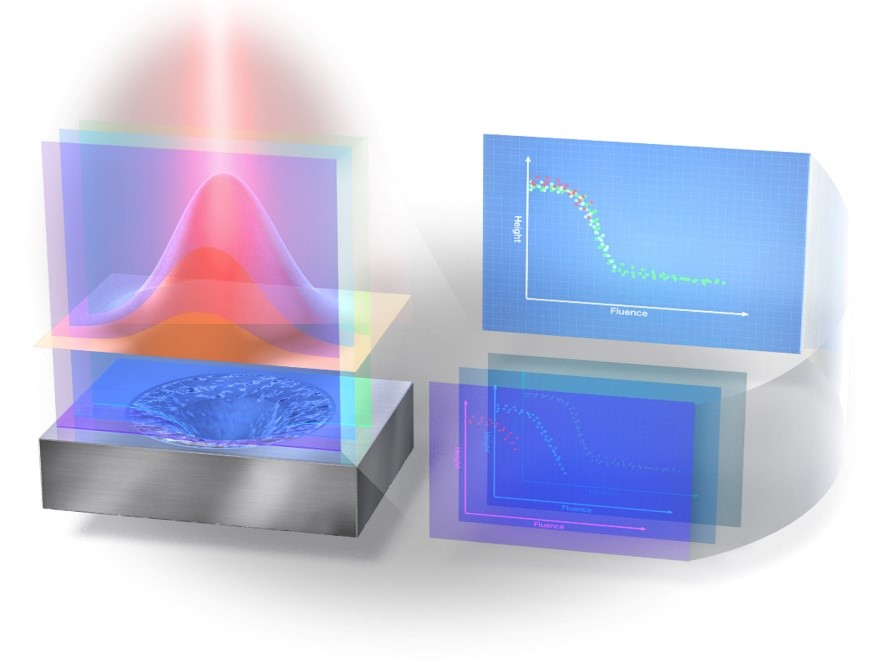
レーザー穴の測定 (左下)レーザーで材料に穴を開けます。(左上)レーザー・フルエンスを測定します。(右下)フルエンスと穴の深さ測定値を重畳します。(右上)次に、フルエンスのみに基づき、穴の深さを計算、これで測定値間の関係が決定されます。 ©2021Sakurai etal
東大:レーザー・フルーエンスマップ法開発:レーザー加工原理解明(動画):
The Univ Tokyo: Laser fluence map method :Elucidation of laser principle:
东京大学:激光通量图方法开发:激光加工原理的阐明
東大:
超短パルスレーザーの照射により、加工穴の深さの入射光強度依存性について,新手法を開発した。
新手法(フルーエンスマップ法):
たった一つのレーザー加工穴から、数十万点のデータを一度に求めることができる。
レーザー加工の原理解明:
レーザー加工を、「設計・制御可能技術として産業応用するには,その原理解明が不可欠」となる。
新手法(フルーエンスマップ法)を用いて、レーザー加工の際に生じている複雑な物理的・化学的現象を解明した。
最近の研究で、「機械学習が、その実現に向けた強力な手法となること」が判明した。
- 強度,
- 波長,
- パルス幅、
レーザー光の条件に対して,「加工穴の深さや形状など大量のデータを、収集すること」が重要である。
レーザー加工穴の作製・測定:
レーザー加工は、不可逆現象である。
原理解明には、「大量のレーザー加工穴の作製と、それらの測定」が不可欠となる。
しかし、実際のレーザー加工現場では実験回数が限られ,大量の学習データを取得することが困難だった。
局所フルーエンスを解析:
- ビームスポット内で、場所ごとにフルーエンスを解析(一つの光パルスのエネルギーをそのビームの面積で割った値)
- 局所フルーエンスが,「スポット近傍ではゼロからピーク値の間で、連続的に変化していること」に着目。
- 「レーザー加工穴の各所での加工深度」は,「入射レーザー光の各所での局所フルーエンスに依存すること」を解明した。
この依存性こそが,「どれくらいのレーザー光強度で物質の破壊が生じるのか」という情報である。
これを正確に把握すれば,「多数の加工穴を作製し実験を行なった場合と、同等な情報」を得ることができる。
OPTRONICS ONLINE オプトロニクスオンライン
https://optronics-media.com/news/20210330/72686/
Laser lights the way
A new way to observe laser interactions could improve laser-based manufacture
March 29, 2021
Despite the enormous amount of research over the decades into lasers and their applications,
there have been few ways to accurately, efficiently, and directly observe fine details of their interactions with materials.
For the first time,
researchers have found a way
to acquire such data from a production laser using low-cost equipment that could vastly improve the accuracy of items cut or etched with lasers.
Given the ubiquity of lasers, this could have wide-ranging implications in laboratory, commercial and industrial applications.
“To measure how far into a surface a laser has cut often requires tens or hundreds of depth readings to take place.
This is a substantial barrier for fast, automated laser-based production systems,” said Professor Junji Yumoto from the Department of Physics at the University of Tokyo.
“So we have devised a new way to determine and predict the depth of a hole produced by laser pulses based on a single observation rather than tens or hundreds.
This finding is an important step forward in improving the controllability of laser processing.”
Yumoto and his team
wondered how to determine the depth of a laser hole using the minimal amount of information possible.
This led them to look at what is known as the fluence of a laser pulse, which is the optical energy the pulse delivers over a given area.
As their test laser apparatus
made a hole on sapphire, the camera recorded directly the fluence distribution of a laser pulse.
Then a laser microscope measured the hole shape.
By superimposing these two results and using some modern numerical methods,
the team produced a large and reliable data set that could accurately tell you the relation between fluence and hole depth.
“This would be correspondent with the extraction of about 250,000 data points from a single measurement,” said Yumoto.
Our new method
could efficiently provide big data for machine learning and new numerical simulation methods to improve the accuracy and controllability of laser processing for manufacture.
The University of Tokyo
https://www.u-tokyo.ac.jp/focus/en/press/z0508_00171.html
A New Way To Observe Laser Interactions Could Improve Laser-Based Manufacturing – SciTechDaily